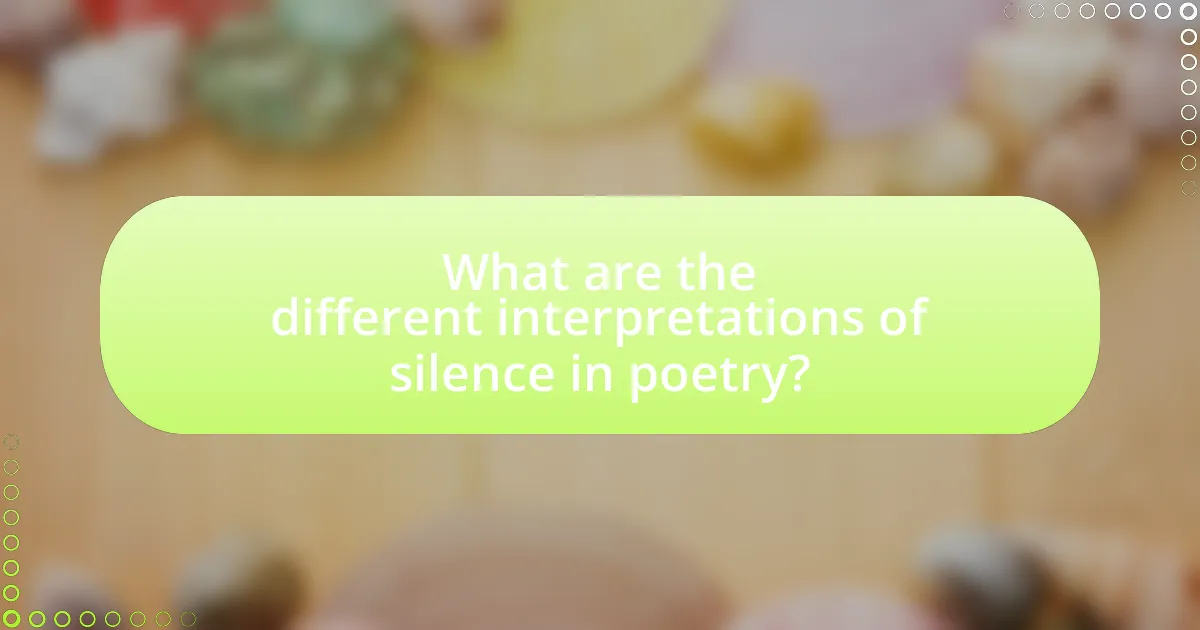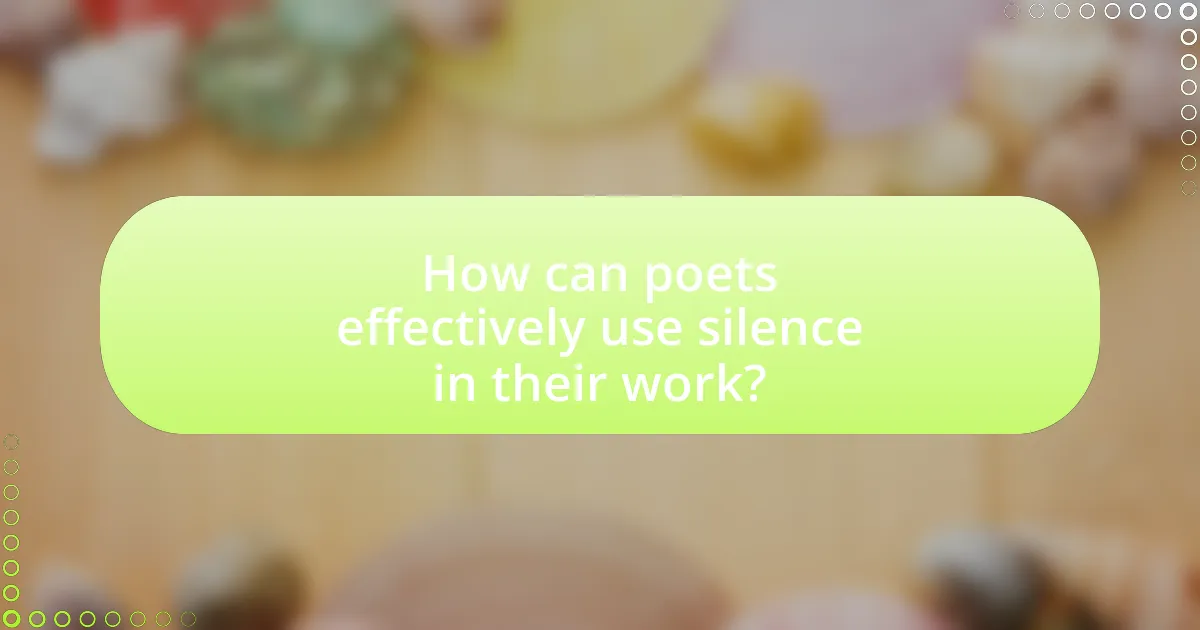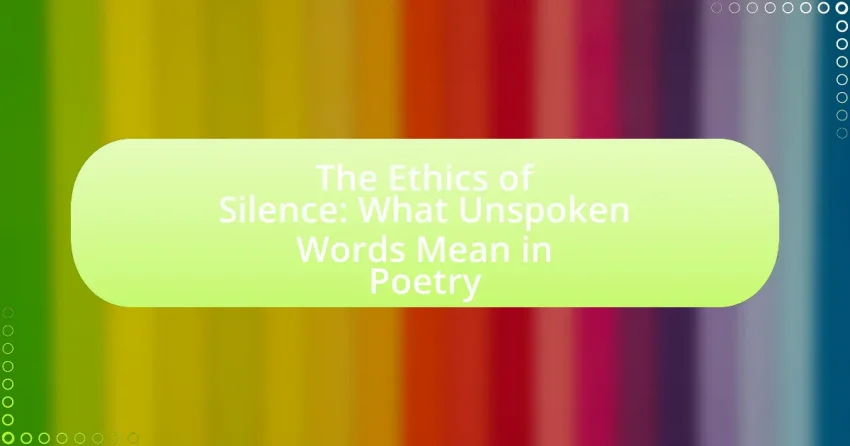The article explores the concept of “The Ethics of Silence” in poetry, focusing on the moral implications and responsibilities of unspoken words in poetic expression. It examines how silence can convey emotions, create layers of meaning, and enhance the reader’s engagement with the text. Key discussions include the influence of cultural and historical contexts on the interpretation of silence, the psychological effects of unspoken words, and practical strategies for poets to effectively incorporate silence into their work. The article emphasizes the significance of intentionality in using silence, highlighting its potential to enrich the emotional landscape of poetry.

What is the Ethics of Silence in Poetry?
The Ethics of Silence in Poetry refers to the moral implications and responsibilities associated with what is left unsaid in poetic expression. Silence in poetry can serve as a powerful tool, conveying emotions, themes, and ideas that words may fail to express, thus inviting readers to engage with the text on a deeper level. For instance, poets like Emily Dickinson often employed silence to evoke feelings of isolation and introspection, suggesting that the absence of words can be as meaningful as their presence. This ethical consideration emphasizes the importance of intentionality in choosing when to speak and when to remain silent, as it shapes the reader’s interpretation and emotional response.
How do unspoken words influence poetic expression?
Unspoken words significantly influence poetic expression by creating layers of meaning and emotional depth. Poets often utilize silence and the absence of words to evoke feelings, allowing readers to interpret the unsaid, which can resonate more profoundly than explicit language. For instance, the use of ellipses or pauses in poetry invites readers to fill in the gaps, fostering a personal connection to the text. This technique is evident in works by poets like Emily Dickinson, who frequently employed ambiguity and silence to enhance emotional impact, demonstrating that what remains unspoken can be as powerful as the words themselves.
What role does silence play in conveying emotions in poetry?
Silence in poetry serves as a powerful tool for conveying emotions by creating pauses that enhance meaning and evoke feelings. These moments of silence allow readers to reflect on the weight of unspoken thoughts, intensifying the emotional impact of the words that are present. For instance, poets like Emily Dickinson often employed dashes and line breaks to create silence, which invites contemplation and deepens the reader’s emotional engagement with the text. This technique underscores the significance of what is left unsaid, illustrating how silence can express longing, grief, or tension, thereby enriching the overall emotional landscape of the poem.
How can silence enhance the meaning of spoken words in a poem?
Silence can enhance the meaning of spoken words in a poem by creating a contrast that emphasizes emotional depth and significance. When a poet strategically incorporates pauses or moments of silence, it allows the audience to reflect on the spoken words, thereby intensifying their impact. For instance, in works like T.S. Eliot’s “The Love Song of J. Alfred Prufrock,” the use of silence between lines invites readers to ponder the weight of the speaker’s insecurities and desires, making the spoken words resonate more profoundly. This technique is supported by research in literary analysis, which shows that silence can serve as a powerful rhetorical device that shapes interpretation and emotional response, ultimately enriching the overall experience of the poem.
Why is silence considered an ethical choice in poetry?
Silence is considered an ethical choice in poetry because it allows for the expression of complex emotions and ideas that words may fail to capture. This choice respects the weight of certain experiences, acknowledging that some subjects, such as trauma or grief, may be too profound for verbal articulation. For instance, poets like Emily Dickinson often employed silence to evoke deeper reflection, allowing readers to engage with the unsaid and interpret meaning on a personal level. This ethical dimension emphasizes the importance of what is left unspoken, fostering a space for contemplation and emotional resonance.
What are the moral implications of choosing silence over words?
Choosing silence over words can carry significant moral implications, as it often reflects a decision to withhold expression that could influence understanding or action. Silence may signify complicity in the face of injustice, as remaining silent can allow harmful situations to persist unchallenged. For instance, historical examples such as the silence of bystanders during the Holocaust illustrate how inaction can contribute to moral failures. Conversely, silence can also serve as a powerful form of resistance or contemplation, allowing for reflection and deeper understanding before speaking. This duality highlights that the moral weight of silence is context-dependent, where the implications can range from tacit approval of wrongdoing to a deliberate choice for thoughtful engagement.
How does silence reflect the poet’s intent and responsibility?
Silence in poetry reflects the poet’s intent and responsibility by serving as a powerful tool for conveying meaning and emotion without explicit words. The deliberate use of silence allows poets to create tension, evoke contemplation, and invite readers to engage with the underlying themes and emotions present in the work. For instance, in works like T.S. Eliot’s “The Love Song of J. Alfred Prufrock,” the pauses and gaps in dialogue emphasize the protagonist’s internal struggles and societal anxieties, showcasing the poet’s responsibility to represent complex human experiences authentically. This strategic use of silence underscores the ethical dimension of poetry, where unspoken words can carry significant weight and provoke deeper reflection on the subject matter.

What are the different interpretations of silence in poetry?
Silence in poetry can be interpreted in various ways, including as a symbol of absence, a space for reflection, or a means of conveying emotion. The absence interpretation suggests that silence represents what is left unsaid, highlighting themes of loss or longing. The reflective space interpretation indicates that silence allows readers to pause and contemplate the deeper meanings of the text, creating a moment of introspection. Lastly, silence can convey powerful emotions, such as grief or tension, where the unspoken words amplify the intensity of the feelings being expressed. These interpretations are supported by numerous poetic works, such as T.S. Eliot’s “The Love Song of J. Alfred Prufrock,” where silence underscores the protagonist’s internal struggles and hesitations.
How do cultural contexts shape the understanding of silence in poetry?
Cultural contexts significantly shape the understanding of silence in poetry by influencing the meanings attributed to unspoken words and the emotional weight of silence. For instance, in Eastern cultures, silence may be viewed as a form of respect or contemplation, often conveying deeper meanings than spoken language, while in Western cultures, silence can be interpreted as discomfort or a lack of communication. This divergence is evident in the works of poets like Matsuo Bashō, whose haikus often embrace silence as a means of evoking nature’s tranquility, contrasting with the more explicit expressions found in Western poetry. Such cultural interpretations highlight how silence can serve as a powerful tool for conveying complex emotions and ideas, reflecting the values and beliefs inherent in different societies.
What examples illustrate varying interpretations of silence across cultures?
Silence is interpreted differently across cultures, with examples highlighting these variations. In Japanese culture, silence often signifies respect and contemplation, particularly in communication, where pauses can convey deep thought or agreement. Conversely, in many Western cultures, silence may be perceived as awkwardness or a lack of engagement, prompting individuals to fill the void with conversation. Additionally, among Indigenous cultures in North America, silence can be a powerful form of communication, used to honor the significance of a moment or to reflect on shared experiences. These interpretations underscore the complexity of silence, revealing its multifaceted role in human interaction and cultural expression.
How does historical context influence the perception of silence in poetic works?
Historical context significantly influences the perception of silence in poetic works by shaping the themes, emotions, and societal implications associated with unspoken words. For instance, during periods of political oppression, such as the Harlem Renaissance, poets like Langston Hughes used silence to convey the struggles of African Americans, highlighting the weight of unexpressed pain and resistance. This historical backdrop informs readers that silence can symbolize both oppression and resilience, altering its interpretation based on the societal conditions of the time. Additionally, the silence in poetry from wartime eras often reflects loss and mourning, as seen in the works of Wilfred Owen, where the absence of words underscores the horrors of conflict. Thus, the historical context provides a framework that enriches the understanding of silence, making it a powerful tool for conveying complex emotional and social narratives.
What are the psychological effects of silence in poetry?
Silence in poetry can evoke a range of psychological effects, including introspection, emotional resonance, and heightened tension. The absence of words allows readers to engage deeply with their own thoughts and feelings, fostering a personal connection to the poem. Research indicates that silence can enhance the emotional impact of a piece, as it creates space for reflection and interpretation, allowing readers to fill in the gaps with their own experiences. For instance, studies in literary psychology show that moments of silence can amplify the themes of loss or longing, making the emotional experience more profound.
How does silence affect the reader’s emotional response to a poem?
Silence significantly enhances the reader’s emotional response to a poem by creating space for reflection and interpretation. This absence of sound allows readers to engage more deeply with the text, prompting them to explore their own feelings and thoughts in relation to the poem’s themes. Research indicates that silence can evoke a heightened sense of anticipation and emotional intensity, as it often emphasizes the weight of unspoken words or feelings within the poem. For instance, studies in literary analysis show that moments of silence can lead to increased emotional engagement, as readers fill in the gaps with their personal experiences and emotions, thereby deepening their connection to the poem.
What psychological theories explain the impact of unspoken words in literature?
Psychological theories that explain the impact of unspoken words in literature include the theory of implicit communication and the concept of the unsaid in psychoanalysis. Implicit communication suggests that unspoken words convey meaning through context, emotions, and subtext, allowing readers to infer deeper emotional truths. Psychoanalytic theory, particularly as articulated by Sigmund Freud, posits that what is left unsaid often reveals unconscious desires and conflicts, influencing character motivations and reader interpretations. These theories highlight how silence and omission can create tension and resonance in literary works, enhancing emotional engagement and thematic depth.

How can poets effectively use silence in their work?
Poets can effectively use silence in their work by strategically incorporating pauses and white space to enhance emotional impact and meaning. Silence allows readers to reflect on the weight of unspoken thoughts, creating a deeper connection to the poem’s themes. For instance, in works like T.S. Eliot’s “The Love Song of J. Alfred Prufrock,” the use of enjambment and pauses emphasizes the speaker’s internal conflict and hesitation, illustrating how silence can convey complex emotions. This technique not only invites interpretation but also highlights the significance of what is left unsaid, reinforcing the poem’s overall message.
What techniques can poets employ to convey silence meaningfully?
Poets can employ techniques such as enjambment, white space, and imagery to convey silence meaningfully. Enjambment allows thoughts to flow over lines without punctuation, creating a sense of continuation that can evoke the feeling of unspoken words. White space on the page visually represents silence, drawing attention to the absence of text and prompting readers to reflect on what is not said. Imagery can evoke silence by depicting serene or still scenes, allowing readers to experience the quietness through vivid descriptions. These techniques effectively highlight the significance of silence in poetry, as seen in works by poets like Emily Dickinson, who often used these methods to explore themes of absence and unexpressed emotions.
How can punctuation and line breaks enhance the effect of silence?
Punctuation and line breaks can enhance the effect of silence by creating pauses that allow readers to reflect on the unspoken elements of a poem. For instance, a strategically placed ellipsis can suggest an unfinished thought, evoking a sense of lingering silence, while a line break can isolate a word or phrase, emphasizing its significance and inviting contemplation. This technique is supported by the work of poets like E.E. Cummings, who utilized unconventional punctuation and spacing to create moments of silence that deepen emotional resonance. Such methods effectively transform the reading experience, making silence a powerful component of poetic expression.
What role does imagery play in representing silence in poetry?
Imagery plays a crucial role in representing silence in poetry by evoking sensory experiences that convey absence or stillness. Poets utilize vivid descriptions of landscapes, objects, or emotions to create a sense of quietude, allowing readers to feel the weight of unspoken words. For instance, in works like “The Waste Land” by T.S. Eliot, imagery of desolate settings reflects the profound silence of despair and disconnection. This use of imagery not only illustrates the concept of silence but also deepens the emotional resonance, as readers can visualize and internalize the silence being portrayed.
What are common pitfalls when using silence in poetry?
Common pitfalls when using silence in poetry include ambiguity, misinterpretation, and lack of emotional impact. Ambiguity arises when silence is not clearly defined, leading readers to draw varied conclusions that may not align with the poet’s intent. Misinterpretation can occur if the silence is perceived differently by diverse audiences, potentially distorting the poem’s message. Additionally, silence may lack emotional impact if it is overused or not strategically placed, resulting in a disconnect between the reader and the poem’s emotional core. These pitfalls highlight the importance of intentionality and clarity when incorporating silence into poetic works.
How can overuse of silence detract from a poem’s message?
Overuse of silence can detract from a poem’s message by creating ambiguity that obscures the intended meaning. When silence is excessively employed, it may lead readers to misinterpret the emotional tone or thematic elements, as the lack of verbal cues can result in confusion. For instance, a poem that relies heavily on pauses might fail to convey urgency or significance, causing the reader to disengage or misunderstand the core message. This phenomenon is supported by literary analysis, which indicates that effective use of silence should enhance rather than hinder clarity, as seen in works by poets like T.S. Eliot, where silence serves a purpose in emphasizing key themes rather than overwhelming the reader with uncertainty.
What strategies can poets use to avoid misinterpretation of silence?
Poets can avoid misinterpretation of silence by employing clear contextual cues and intentional imagery. By providing surrounding text that frames the silence, poets can guide readers toward the intended emotional or thematic interpretation. For instance, using contrasting language before or after a silent moment can clarify its significance, as seen in works where silence follows a moment of tension, emphasizing its weight. Additionally, poets can utilize punctuation strategically, such as ellipses or dashes, to indicate pauses that suggest contemplation rather than ambiguity. This technique helps to signal the reader’s emotional response, reducing the likelihood of misinterpretation.
What practical tips can poets follow to master the ethics of silence?
Poets can master the ethics of silence by intentionally incorporating pauses and white space in their work. This technique allows for reflection and emphasizes the weight of unspoken words, creating a deeper emotional impact. For instance, using enjambment can create a natural pause, inviting readers to contemplate the meaning behind the silence. Additionally, studying works by poets like Emily Dickinson, who often employed silence to convey complex emotions, can provide valuable insights into effective use of silence in poetry. By analyzing how silence shapes meaning in their own writing, poets can enhance their craft and communicate more powerfully.
